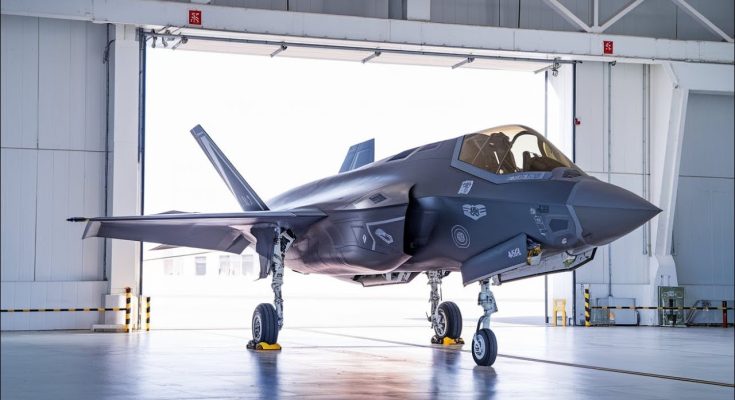2025 F-35 Fighter Jet: America’s Answer to China’s Growing Threat
As tensions between the United States and China continue to rise, particularly in the Pacific region, the need for advanced, cutting-edge fighter jets has never been more pressing. In this high-stakes environment, the 2025 F-35 Lightning II is poised to become a key asset for the U.S. military, solidifying its position as a global leader in air combat technology. Designed with advanced stealth, sensor fusion, and multirole capabilities, the F-35 is America’s answer to China’s rapidly advancing military capabilities, particularly in the realm of 6th-generation fighter development.
The F-35: America’s Multirole Masterpiece
The F-35 Lightning II, developed by Lockheed Martin, is one of the most advanced fighter aircraft in the world, designed to fulfill multiple roles across all branches of the U.S. military and its allies. Available in three variants (F-35A for conventional takeoff and landing, F-35B for short takeoff and vertical landing, and F-35C for carrier-based operations), the F-35 is unparalleled in its ability to operate in diverse environments.
What sets the F-35 apart is its stealth capabilities, which significantly reduce its radar cross-section, making it harder for enemy radars to detect. The aircraft’s sensor fusion technology integrates data from radar, infrared sensors, and other onboard systems, providing the pilot with an unparalleled level of situational awareness. This combination of stealth and sensor fusion allows the F-35 to operate deep in enemy territory with a high degree of survivability.
China’s 6th-Generation Fighter Jet: The Challenge
China has been actively developing its own advanced aircraft, and its ambitions go beyond the current 5th-generation fighters like the J-20. China’s 6th-generation fighter jet program, often referred to as the “J-XX”, aims to create an aircraft that surpasses the capabilities of the F-35, F-22, and other current-generation platforms. While still in the early stages of development, China’s 6th-gen fighter is expected to incorporate cutting-edge technologies such as hypersonic speed, advanced AI, enhanced stealth, and the ability to operate in highly contested environments.
China’s AI and autonomy-focused design in its 6th-generation fighter could grant it capabilities for unmanned operations, improved mission planning, and enhanced decision-making in real-time. Moreover, the J-XX is likely to integrate advanced weapons systems, including hypersonic missiles, and could be designed to operate seamlessly with drones and other unmanned platforms.
This development represents a serious challenge to the U.S. and its allies, as it indicates that China is moving quickly toward a new era of fighter aircraft that could potentially outpace current American capabilities.
F-35’s Strategic Edge Against China’s Growing Threat
In response to China’s advancements, the 2025 F-35 continues to be a crucial component of U.S. military strategy. While China’s 6th-gen fighter may bring new challenges, the F-35’s versatility and adaptability make it a formidable counter in modern warfare. The F-35’s multirole capabilities, including air superiority, strike missions, electronic warfare, and intelligence gathering, allow it to remain effective in both conventional and unconventional combat scenarios.
One of the F-35’s most significant advantages is its ability to integrate into a broader network of advanced technologies. The aircraft can share information in real-time with other fighters, drones, satellites, and command centers, providing the U.S. military with a massive combat network advantage. This connectivity allows for a level of cooperation and coordination that a single, standalone 6th-gen fighter could struggle to achieve.
Additionally, the F-35’s continued upgrades, particularly in avionics, weapons, and stealth technologies, ensure that it will remain a formidable force well into the future. The aircraft is constantly being updated, ensuring that it can keep pace with China’s advancements and counter emerging threats.
A Global Advantage in an Evolving Battlefield
As the U.S. faces off against China in an increasingly complex and dynamic military environment, the 2025 F-35 serves as a key pillar of air combat strategy. With its unmatched versatility, advanced stealth, and connectivity, the F-35 is designed not only to engage in direct aerial combat but also to function as part of a larger network of systems that can outmaneuver and outfight any adversary. In a world where technological superiority often determines the outcome of conflict, the F-35 will continue to be a decisive asset in ensuring U.S. air dominance.
While China’s 6th-generation fighter may introduce a new chapter in air combat, the F-35 represents the next evolution of American air power, designed to maintain a strategic edge in an era of rapid technological advancements and increasing global tensions. The ongoing development of both the F-35 and emerging technologies will ensure that the U.S. remains at the forefront of air combat for years to come, capable of meeting the growing challenges posed by China’s expanding military capabilities.
Conclusion
The 2025 F-35 Lightning II is more than just a fighter jet; it’s a response to the rapidly evolving threats posed by nations like China. While China’s 6th-generation fighter represents a formidable challenge, the F-35’s unmatched multirole flexibility, advanced stealth, and AI-driven capabilities ensure that it will remain a key asset for the U.S. and its allies. As the world enters a new age of air combat, the F-35 will continue to be America’s answer to maintaining air superiority, countering emerging threats, and shaping the future of warfare.



